EC225/H225 Main Rotor Head and Main Gear Box Design
Following the recent tragic accident at Turøy near Bergen, Norway involving EC225/H225 LN-OJF there is a lot of interest in the Main Rotor (MR) and Main Gear Box (MGB) design of the EC225. Here we provide some background information on the design.
The EC225/H225 MRH/MGB Design
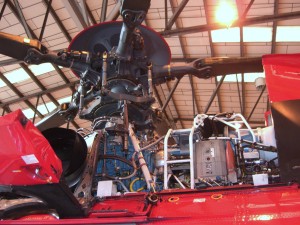
EC225 MRH and MGB (c) Aerossurance
Unlike some other types, the 11t+ lift load from the Main Rotor is not imposed on the casing of the MGB, but is instead transferred via a Double Taper Bearing to the Lift Housing (see the diagram below). When static the Double Taper Bearing also transmits the weight of the MR assembly to the Lift Housing.
The Lift Housing is connected to the fuselage via three Suspension Bars (which connect to fittings secured to the fuselage by 4 bolts). The Lift Housing also takes the suspended weight of the MGB via the Flared Housing. The MGB is supported underneath by the flexible titanium Barbeque Plate which absorbs the MR torque, longitudinal and transverse loads and damps out vibrations.
The EC225 has a integral Main Rotor Head (MRH) and MR shaft, which mates with output of the MGB Epicyclic Module via a spline. The five Blade Sleeves (and their associated Blade Dampers) are attached to the MRH. The composite Main Rotor Blades (MRBs) are fitted to the Blade Sleeves.
As is conventional on a helicopter, the pitch of the MRBs is controlled by Pitch Change Rods connecting the Rotating Swashplate to the Blade Sleeves. The Rotating Swashplate follows the position of the Non-Rotating Swashplate, which is moved by three flying control Servo Units (not shown above), in responses to movement of the pilot’s Cyclic and Collective Controls. The Rotating Swashplate oscillates around a ball joint which can also slide up and down a Guide Tube that surrounds the MR Shaft. Each part of the Swashplate has a two part articulating Scissor. The one connected to the MRH drives the Rotating Swashplate, while the one connected to the Lift Housing prevents the Non-Rotating Swashplate from rotating.
The MGB is modular, with a main module which drives an epicyclic module and two accessory modules. Drive from the two 2101 shp Turbomeca Makila 2A engines enters the front of the MGB via two high speed (22962 rpm) shafts (known as Bendix shafts). The MGB Main Module and the 2 stage Epicyclic Module reduce the speed to the nominal Main Rotor speed of 265 rpm. The Main Module also drives various accessories and the Tail Rotor Drive Shaft (TRDS).
The LN-OJF Investigation
The independent Accident Investigation Board Norway (AIBN – the Statens Havarikommisjon for Transport [SHT] in Norwegian) is leading the LN-OJF accident investigation in accordance with the International Civil Aviation Organisation (ICAO) Annex 13 on air accident investigation.
The AIBN have issued the following press releases:
- 1 May 2016 The Helicopter Accident: The work continues
- 2 May 2016 The Helicopter Accident: Data from the combined FDR and CVR retrieved. Data is of good quality
- 6 May 2016 The Helicopter Accident: The search for components is resumed
- UPDATE 13 May 2016: The AIBN issue their preliminary report (see below).
- UPDATE 27 May 2016: A second preliminary report is issued (see below).
- UPDATE 31 May 2016: Airbus Helicopters clarifies an earlier press release (see below).
- UPDATE 1 June 2016: A third preliminary report is issued (see below).
- UPDATE 28 June 2016: A fourth preliminary report is issued (see below)
- UPDATE 3 July 2016: We have prepared a comprehensive timeline on the investigation progress.
The Preliminary Report issued 13 May 2016 states:
The AIBN is currently focussing on the examination of the MRH suspension bar assembly, the main gearbox and the main rotor head. Retrieved wreckage parts and other components are stored for future examinations as required.
However, several key components are still missing. A significant sea and land search is ongoing in order to retrieve these components.
At this preliminary stage of the investigation, detailed metallurgical examinations have not been performed. The examinations so far have not shown any sign of fatigue failure.
Health and Usage Monitoring System (HUMS) / Vibration Health Monitoring (VHM) data from the flight has been recovered. VHM data and maintenance records are still to be examined.
The Preliminary Report issued 27 May 2016 states:
…some key components are still missing. These components are in particular the epicyclical second stage planet gear carrier and parts of the forward suspension bar.
The official investigation team led by AIB Norway (AIBN) met at Airbus Helicopters (AH) in Marignane on 24, 25 and 26 May 2016 with the additional participation, BEA France, AAIB UK, EASA, CAA UK and CHC.
The main purpose of this 3 days meeting was to agree on further investigation of the parts that the AIBN had sealed and sent to Airbus Helicopters, and to discuss a list of possible scenarios that could explain the detachment of the main rotor.
The investigation team has discussed a list of scenarios that Airbus Helicopter prepared based on fault tree analysis. At this stage, the AIBN can confirm that the scenarios under consideration include failure of epicyclic module, suspension bar (lift strut) attachment and MGB conical housing.
On 27 May 2016 Airbus Helicopters added that:
According to Airbus Helicopters’ analysis, seven potential initial events have been retained to explain the main rotor detachment of LN-OJF. Out of these seven scenarios, only one – the failure of the attachment of a suspension bar – can been assessed as probable by Airbus Helicopters, based on the information available to date.
At this stage, the exact cause of this possible event is still unknown. Analysis of the helicopter’s maintenance history has just started and should provide a better understanding of the most likely causes.
On 31 May 2016 Airbus Helicopters clarified that:
Airbus Helicopters is not ruling out any of the scenarios described by the AIBN… Although significant progress has been made in analyzing information regarding the suspension bar attachments, more work needs to be done on scenarios involving the epicyclic module and the MGB conical housing.
On 1 June 2016 another preliminary report was published with an urgent safety recommendation addressed to EASA as:
Recent metallurgical findings have revealed features strongly consistent with fatigue in the outer race of a second stage planet gear in the epicyclic module of the MGB. It cannot be ruled out that this signifies a possible safety issue that can affect other MGBs of the same type. The nature of the catastrophic failure of the LN-OJF main rotor system indicates that the current means to detect a failure in advance are not effective.
An EASA Emergency AD was issued the same day (see below).
On 28 June 2016 the fourth preliminary report was issued:
At this stage of the investigation, the AIBN finds that the accident most likely was a result of a fatigue fracture in one of the eight second stage planet gears.
Almost Half of One Particular 2nd Stage Planetary Gear from LN-OJF was Recovered. It was in Two Pieces (Credit: QinetiQ via AIBN)
It appears that the fracture has propagated in a manner which is unlikely to become detected by existing mandatory or supplementary systems for warning of an imminent failure.
Crack In 2nd Stage Planetary Gear from EC225 LN-OJF Viewing the End of One of the Recovered Pieces (Credit: QinetiQ via AIBN)
What initiated the fracture has not yet been determined.
The AIBN say there are similarities (but some differences) to the 1 April 2009 G-REDL AS332L2 accident. The fatigue origin apparently sub-surface near the bearing outer race, propagating outwards towards the teeth.
A Computed Tomography (CT or CAT) scan conducted at the University of Southampton identified sub-surface cracking between patches of inner race surface spalling.
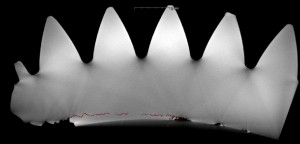
CT scan showing a subsurface crack propagating from the RH spalling to the left. The red colour is a frame-by-frame mapping performed by hand to highlight the crack. (Credit: University of Southampton via AIBN)
The AIBN suggests the crack propagation was contrary to design assumptions that the compressive stress near the surface of the inner race would effect sub-surface cracks. AIBN say no debris had been found previously and no procedural maintenance failures occurred. The AIBN also suggest the defect may not be detectable by HUMS. The AIBN confirm the Time Since New (TSN) of the MGB was 1340 hours (260 hours since installation on LN-OJF on 15 January 2016). Transit damage, mentioned in earlier Airbus Helicopters Emergency Alert Service Bulletins (see 15 June 2016 update below) is still under investigation. Updates are now predicted to be less regular.
Airbus Helicopters takes note of the AIBN’s preliminary report update and welcomes the significant progress made by the investigation. We continue to focus our efforts on providing assistance to the investigation team and the authorities as they work toward the identification of the accident root cause. In parallel, we are putting precautionary measures in place to support our global customers and address potential initiating events.
UPDATE 20 July 2016: It is reported that the Norwegian Government has granted additional funding to the AIBN to cover the extra costs of the investigation:
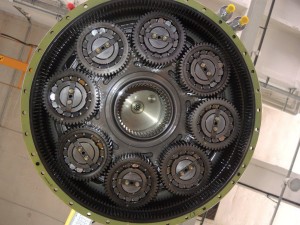
A View from Below of a 2nd Stage Epicyclic Stage. Note the 8 Planet Gears and the Bearings within them (Credit: AAIBN)
EC225 / H225 Type Related Design / Regulatory Action
On the day of the accident the Norwegian Civil Aviation Authority (Luftfartstilsynet) and then the UK CAA issued operational Safety Directives temporarily prohibiting the use of the type for Commercial Air Transport (CAT):
On 3 May 2016 the EASA, the competent authority for airworthiness across the EU and other EASA Member States, issued Emergency Airworthiness Directive (EAD) 2016-0089-E. This called for a mandatory inspection before next flight to:
Check the correct installation of the Front and Right Hand and Left Hand Rear MGB suspension bars in accordance with the instructions of Airbus Helicopters (AH) EC225 Alert Service Bulletin No.53A058.
It also calls for the precautionary examination of the MGB Magnetic Chip Detectors (MCDs), MGB oil filter and the M’ARMS VHM / HUMS.
This AD did result in findings. For example Australian SDR 510023163:
During inspections IAW EASB EC225-53A058, forward suspension bar fitting was found to have bolts more than 20 per cent below the minimum torque as specified in the MMA. Check was previously carried out per AD 2006-0163 four months ago with the results satisfactory. Two similar defects reported. P/No: 332A22161321. TSN: 863 hours/915 cycles.
UPDATE 11 May 2016: Twelve days after the fatal EC225 accident, the NCAA announce that NCAA and UKCAA restrictions are being extended to the AS332L2 but partially relaxed to allow SAR training.
Neither regulator mention any new information and only cite the ‘similarities’ between the helicopters. The EC225 was developed from the AS332L2, though certified to a later certification basis. The gearbox geometry is very similar. Materials were changed to cope with the higher mass of the EC225, a separate oil cooler for the stand-by lubrication oil circuit and an emergency lubrication system added to lengthen the operating time after a loss of MGB oil. The main visible differences are the role of the flared and lift housings of the EC225 were combined in the conical housing of the AS332L and the E225 features a 5 bladed bearingless SPHERIFLEX main rotor, compared to 4 on the AS332L2.
UPDATE 1 June 2016: EASA issue a follow up EAD 2016-0103-E with wider applicability to the AS332L2:
The review of the data reported in accomplishing AD 2016-0089-E, revealed installation findings for the MGB upper deck fittings of the three MBG suspension bars, to include, among others, tightening torque values on the attachment bolts of the fittings being out of tolerance and some incorrect washers positioning in the fitting assemblies.
Prompted by these findings, Airbus Helicopters (AH) issued EC225 ASB No. 53A059 (hereafter referred to as ‘the applicable ASB’ in this AD) to provide further inspection and replacement instructions for correct installation of the MGB suspension bars and attachment fittings.
UPDATE 2 June 2016: NCAA on the 1 June and then UKCAA the next day extend their Safety Directives to stop all EC225 and AS332L2 flights and EASA issued a flight prohibition EAD.
EASA say in the EAD (which does not affect State Aircraft, which remain under national legislation in EASA Member States):
The review of the data reported in accomplishing AD 2016-0089-E, revealed installation findings for the MGB upper deck fittings of the three MBG suspension bars. Prompted by these findings, EASA issued superseding AD 2016-0103-E for further inspection and replacement instructions for correct installation of the MGB suspension bars and attachment fittings.
Soon after EASA AD 2016-0103-E was issued, a second preliminary report from the investigation board indicated metallurgical findings of fatigue and surface degradation in the outer race of a second stage planet gear of the MGB epi-cyclic module. At this time, it cannot be determined if this is a contributing causal factor or subsequent failure from another initiating factor.
Pending further investigation to determine the root cause(s) of the reported damage, and development of mitigating measures by Airbus Helicopters, EASA has decided, as an additional precautionary measure, to temporarily ground the fleet.
For the reason described above, this AD prohibits flight of the AS 332 L2 and EC 225 LP helicopters.
Airbus Helicopters stated that:
In light of new findings from the AIBN’s preliminary accident investigation report, Airbus Helicopters supports EASA’s cautious approach. We continue to fully support the AIBN, EASA, our customers and the ongoing investigation by providing information in full transparency, while working with the wider industry to ensure safety.
UPDATE 3 June 2016: HeliOffshore issued a statement:
This combination of [regulated] processes with a detailed investigation being undertaken by AIBN, supported by Airbus and others, gives us the belief that the root cause will, in time, be fully understood; then and only then, can the appropriate corrective measures be put in place to ensure that the issue is resolved…
Our commitment to the investigation remains absolute; our commitment to identifying and addressing the root cause remains absolute; our commitment through collaboration with all stakeholders, not least the offshore workforce, to only returning the aircraft to service when it is safe to do so remains absolute.
UPDATE 15 June 2016: Airbus Helicopters issue Emergency Alert Service Bulletins (EASBs) on the AS332L2 (EASB 05.01.07), the military AS532A2 and U2 (EASB 05.00.82), the EC225 (EASB 05A049) and military EC725 (EASB 05A045), which effectively are applicable only to aircraft unaffected by the EASA Flight Prohibition. These require:
-
Inspection of the MGB oil filter and chip detectors after the last flight of the day
-
Cessation of flying with epicyclic modules which have been involved in an unusual event since new or Complete Overhaul and return for Complete Overhaul
Airbus Helicopters note the investigation in Norway is on-going and although no conclusions have been reached these EASBs have been introduced as a precautionary measure as:
…the MGB of the helicopter involved in the accident had been subject to a shock impact during road transport a few months previously.
UPDATE 29 June 2016: Airbus Helicopters issue EASBs on the AS332L2 (EASB 63.00.83), the military AS532A2 and U2 (EASB 63.00.38), the EC225 (EASB 63A030) and military EC725 (EASB 63A029). These state:
As a precautionary measure, it was decided to maintain only one of the two types of epicyclic module second stage planet gears in service.
This is because:
- The detailed design of [one type of] the planet gear bearing has an increased damage tolerance.
- Modelling and calculation reveal a lower load level on the external race of the planet gear bearing.
- In-service experience shows enhanced reliability.
The EASBs require the replacement of the other type within 15 flying hours.
Airbus Helicopters have also issued a Safety Information Notice on the potential failure modes originally identified.
UPDATE 27 July 2016: Flight International report that during a half-year results call on 27 July 2016 Airbus Group CEO Tom Enders said:
…the company is making “good progress” with EASA towards understanding how soon the H225 and AS332 fleets might be returned to flight. Airbus Helicopters says talks with EASA are key to lifting the grounding, but declines to comment on any timeline for that to be achieved.
UPDATE 7 October 2016: EASA issue AD 2016-0199 that responds to the AIBN recommendation. HeliOffshore has issued an explanatory statement. We discuss the AD further at: EC225 LN-OJF Accident Investigation Timeline
UPDATE 24 April 2017: The AIBN have announced they will hold a press conference in Lillestrøm Friday 28 April at 1300 hours. Prior to that they will issue a preliminary report on LN-OJF in English:
…in order to present an updated status of the investigation. The report contains mainly factual information available so far in the investigation. The report also contains some AIBN comments.
UPDATE 25 April 2017: The press report that the UK CAA has written to a number of stakeholders. While they say the:
The report is comprehensive (101 pages) and provides significant detail. No new information for the CAA has emerged from the report and there are no safety recommendations.
However:
Developments on the lifting and the detection capability look promising and we are hopeful that after obtaining further information we will be closer to removing our directives. At this time however the [Norwegian and UK] directives remain in place.
UPDATE 28 April 2017: The AIBN have issued a new preliminary report. At 102 pages the report is much closer to a partial final report than a normal preliminary or interim report, with ‘comment’ in section 2, that is effectively ‘analysis’ by another name. We examine that in more detail in our feature: EC225 LN-OJF Norway Accident Investigation Timeline
We look at the components in more detail in our article: Super Puma Second Stage Planet Gear Background
UPDATE 14 June 2017: In the introduction to the Agency’s 12th annual safety review, EASA’s Executive Director Patrick Ky says:
…the tragic accident involving an EC225 helicopter in Norway in April 2016 shows the importance of joining forces and together maintaining safety as an aviation community.
UPDATE 26 June 2017: Speaking prior to the Paris Airshow Airbus CEO Tom Enders said he was “hopeful” that the operational directives on commercial H225 flights in UK and Norway would be lifted “any time soon. But at this time, after so many delays, we are not going to make any predictions.” He commented that these national directives were “somewhat awkward” as “under existing agreements with EASA they should do this [lift their flight restrictions]”.
UPDATE 30 June 2017: Workers asked for North Sea helicopter safety feedback
UPDATE 2 July 2017: Energy Voice Report: Could Super Puma return to North Sea skies?
UPDATE 7 July 2017: The Norwegian and UK CAA operational restrictions are being lifted.
UPDATE 20 July 2017: The UK and Norwegian restrictions are officially lifted.
UPDATE 4 October 2017: Airbus release a video.
UPDATE 24 April 2018: The AIBN made a statement on the LN-OJF investigationthat:
A draft of the final report on the tragic accident near Turøy has been for consultation with the parties involved in the investigation. The consultation period is over and the AIBN is working on the comments. It is solely the AIBN’s decision whether or not a comment shall be accepted and incorporated into the final report. This is a laborious and time-consuming process, which will also involve clarifications and consultation with external contributors.
At the time being, we are unable to present a firm date for publication of the report. The work will continue without letup until the final report is ready for publication.
UPDATE 25 June 2018: The AIBN LN-OJF final report will be issued on 5 July 2018.
UPDATE 5 July 2018: The AIBN final report is issued. They say:
From this investigation there are significant lessons to be learned related to gearbox design, safety assessment, fatigue evaluation, condition monitoring, certification requirements and continued airworthiness of the AS 332 L2 and the EC 225 LP helicopters, which also could be valid for other helicopter types.
Based on this investigation, the AIBN issues 12 safety recommendations.
Airbus comment:
Prior to 2016, the available degree of scientific and technical knowledge meant it was neither foreseeable nor foreseen that a crack in a plant gear could propagate in a sub-layer, and as a result generate very low levels of detectable particles.
With knowledge gained from this investigation, Airbus Helicopters has introduced a series of safety measures on the H225. Some of the technology that has been developed is ground-breaking for the helicopter industry.
Final Words
On Monday 2 May 2016, three days after the accident, the Bergens Tidende newspaper editorial has some thoughtful and balanced comments (translated extracts) that are relevant to any accident:
Speculation in causes must be met with both scepticism and openness simultaneously. Scepticism because no one should be blamed unjustly. Openness because there is always a danger that investigators overlook important factors.
Once the cause of the accident is clear, it will provide an important explanation for the bereaved. But the answer will still be uncomfortable, because something or someone has failed. Whether it was due to a technical or human error, the system is designed to prevent this happening. Systems will never be perfect, and 100% safety is unattainable.
Therefore, it is also essential to a thorough investigation to find the answer. It must lead to better safety practices. A similar failure should not happen again.
Indeed the investigators, industry and the regulators are working tirelessly to do just that.
UPDATE 13 May 2016: On the eve of the second HeliOffshore safety conference, Les Linklater of Step Change In Safety wrote: Leading the hard way, not learning the hard way:
HeliOffshore, the global helicopter industry’s collaborative safety association, will hold their annual conference in Prague this coming weekend where over 180 CEOs and other senior leaders from helicopter operators, manufacturers and others will work to align behind a global safety strategy to put momentum behind those actions that will make the greatest difference to safety.
It is events like these, combined with the unyielding commitment to safety from their CEO, Gretchen Haskins, that help me retain faith that we will prevail in the end, regardless of the difficulties.
That said we must confront the most brutal facts of our current reality, whatever they might be. There is no doubt that we will find the root cause of the accident, and in time, that the H225 will be cleared for a return to service.
We have to accept that no matter what assurances are given that everything that can be done has been done, workers and their families will still feel anxious at the prospect of flying.
The proximity and apparent similarity of these events fuels our emotions but I caution against jumping to conclusions or the use of such tragedy in a political or industrial relations arena. Thirteen people lost their lives whilst travelling home.
No loss of life can ever be considered acceptable and what we must call for now is an absolute commitment to leading the hard way, rather than learning the hard way.
Indeed HeliOffshore has committed to a ‘root and branch review’ of helicopter safety, which we discuss in our HeliOffshore conference report.
Other Resources
UPDATE 3 July 2016: We have prepared a comprehensive timeline on the LN-OJF investigation progress.
UPDATE 23 September 2016: Statoil issue their internal investigation into their handling of the accident and flight safety.
See also:
- Aircraft Accident Report 2/2011 – Aerospatiale (Eurocopter) AS332 L2 Super Puma, G-REDL, 1 April 2009
- AAIB 2012 Annual Safety Report (in which most of the responses to the G-REDL investigation are examined)
- G-REDL Fatal Accident Inquiry held under a Sheriff in Aberdeen in 2014
- AAIB Report on the Ditchings of EC225 G-REDW 10 May 2012 & G-CHCN 22 Oct 2012 (on two prior unrelated EC225 shaft failures)
UPDATE 30 December 2016: This was our most popular article of 2016.

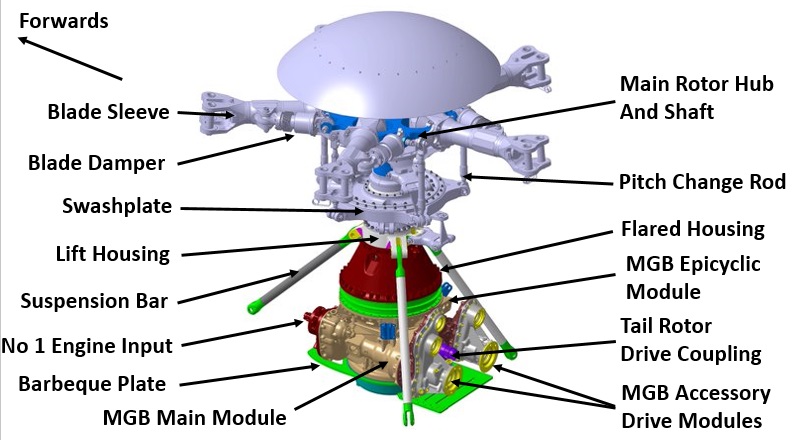

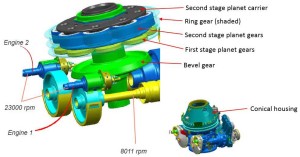


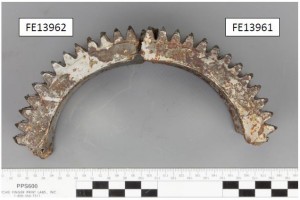



Recent Comments